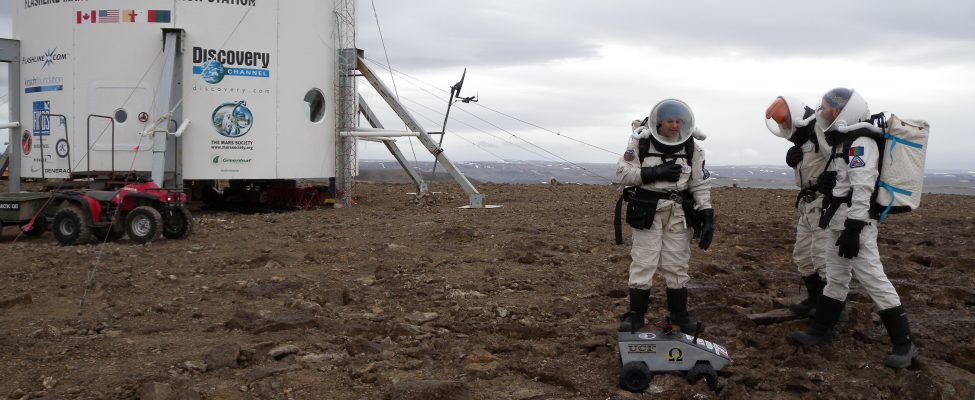Flashline Mars Arctic Research Station

Address
The Mars Society11111 W 8th Ave.,
Suite A, Lakewood,
CO 80215,USA
Station manager
Susan Holden MartinContact Station
www.fmars.marssociety.orgStation Features
Opening year: 2001 Status: OpenFacilities
Station name and owner
Flashline Mars Arctic Research Station is one of two simulated Mars habitats owned and operated by The Mars Society, Inc. – a U.S. non-profit organisation.
Location
The station is located on Devon Island, a Mars analog environment and polar desert, approximately 165 km northeast of the hamlet of Resolute in Nunavut, Canada (75°25’ N, 89°49’ W). The station is situated on Haynes Ridge, overlooking the Haughton impact crater, a 23 km diameter crater formed approximately 39 million years ago (late Eocene). The location is approximately 1609 km from the Geographic North Pole and approximately 1287 km from the Magnetic North Pole.
Climate data
Grey colours are WMO Climate Normals including maximum and minimum values. Blue colours are individual years.
Climate data for the stations where extracted via Copernicus Climate Data Store, from the global gridded reanalysis product:
ERA5 monthly averaged data on single levels from 1940 to present.
Description and source code: Roemer J.K. 2023. https://doi.org/10.5281/zenodo.10214922
Data Source: Hersbach et al. 2023. Copernicus Climate Change Service (C3S) Climate Data Store (CDS), https://doi.org/10.24381/cds.f17050d7
Biodiversity and natural environment
Because of its relatively high elevation and its extreme northern latitude, Devon Island supports only a meagre population of small birds and mammals, including muskoxen. Animal life is concentrated in the Truelove Lowland area of the island, which has a favorable microclimate and supports relatively lush arctic vegetation. Temperatures during the brief growing season seldom exceed 10 °C and in winter can plunge to as low as -50 °C. With a polar desert ecology, Devon Island receives very little precipitation. Cape Liddon is an Important Bird Area (IBA) notable for its black guillemot and northern fulmar populations. Cape Vera, another IBA site, is also noted for its northern fulmar population. Devon Island is also notable for the presence of the Haughton impact crater, created some 39 million years ago when a meteorite about 2 km in diameter crashed into what were then forests. The impact left a crater approximately 23 km in diameter, which was a lake for several million years.
History and facilities
The Flashline Station was built by The Mars Society in 2001, and since then it has been used to conduct planetology studies: geological, biological, and climatology studies under conditions similar to those found on Mars, and to develop field tactics based on those explorations, to test habitat design features, tools, and technologies, and to assess crew selection protocols essential to future human spaceflight.
General research and databases
Experiments at Flashline primarily focus on biodiversity surveys of the arctic desert and geological/geophysical study of the Haughton Crater area. Other experiments included a geophysical analysis of Haughton Crater which answered key questions on the physical characteristics of the 20-million year old meteor crater and examined microfossils in crater soil deposits. Logistics and engineering experiments are also conducted.
Station Monitoring
Human dimension
The Mars Society invites researchers to live and work at the station, typically for one month during the arctic summer. Expeditions typically consist of a crew of between six and seven individuals. Typically 1 to 2 months prior to departing for the Canadian Arctic, the crew gathers for an initial face-to-face meeting and training session in Colorado, USA. The station’s primary mission is to help develop key knowledge needed to prepare for human Mars exploration, and to inspire the public by making real the vision of human exploration of Mars. The station is 165 km northeast of Resolute/ Qausuittuq, Nunavut, where 80% of the population is Inuit.
Access
Due to the harsh and dangerous environment of the Arctic, crew members must file an application for consideration and complete orientation and training prior to visiting the station. Crew members must travel by commercial airline to Resolute Bay, Canada. There they spend a few days organizing supplies and equipment and conducting some final training while waiting for clear weather. They then board a Twin Otter aircraft for the final leg of the journey to Devon Island. The primary means of crew transportation while on the island is by ATVs.

